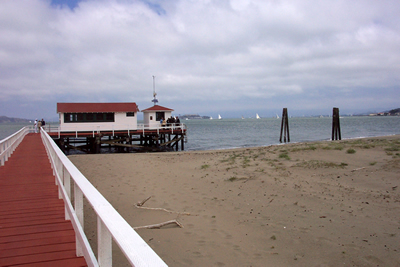Unaweep Canyon in the Rocky Mountains includes a deep gorge with ancient landscapes and sediments. The inset image is of a "dropstone" from an ancient glacier.
Click on image for full size
Image Courtesy of Gerilyn Soreghan
Cold and Ice, and Heat, Episodically Gripped Tropical Regions 300 Million Years Ago
News story originally written on July 31, 2008
For a long time scientists have thought that the tropics stayed warm when much of the Earth was covered with glaciers 300 million years ago. But scientists have learned this wasn't the case. In fact, the tropics experienced cold temperatures at that time.
Scientists found evidence for this in an ancient glacial landscape in the Rocky Mountains of western Colorado. Three hundred million years ago, the region was part of the tropics when the continents were part of the supercontinent Pangaea.
The ancient tropical glaciers were very close to the ocean, so the toes of the glaciers were probably less than 500 meters (1,640 feet) above sea level. This is much lower than the tropical glaciers on Earth during more recent glacial times.
This study shows that the Earth contains great amounts of information about its past climates, and discovering this type of information may help us understand and predict modern climate change."
You might also be interested in:

This page is not yet developed at the elementary level. Please check back for updates or click on the "Intermediate" button above for information.
...more
Sea level is the height of the ocean surface. Scientists measure sea level to figure out how much sea level rise is happening now because of global warming. If you tried to draw a flat line at the top
...more
Have you ever taken your temperature to see if you are getting sick? Scientists have been taking the Earth's temperature and have found that it is getting warmer. During the past 100 years, the Earth's
...more
Scientists have learned that Mount Hood, Oregon's tallest mountain, has erupted in the past due to the mixing of two different types of magma. Adam Kent, a geologist at Oregon State University, says this
...more
The Earth's mantle is a rocky, solid shell that is between the Earth's crust and the outer core. The mantle is made up of many different reservoirs that have different chemical compositions. Scientists
...more
Some faults look strong and like they wouldn’t cause an earthquake. But it turns out that they can slip and slide like weak faults causing earthquakes. Scientists have been looking at one of these faults
...more
The sun goes through cycles that last approximately 11 years. These solar cycle include phases with more magnetic activity, sunspots, and solar flares. They also include phases with less activity. The
...more















